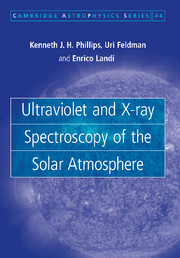Book contents
- Frontmatter
- Contents
- Preface
- 1 The solar atmosphere
- 2 Fundamentals of solar radiation
- 3 Fundamentals of atomic physics
- 4 Mechanisms of formation of the solar spectrum
- 5 Plasma diagnostic techniques
- 6 Ultraviolet and X-ray emission lines
- 7 Spectrometers and imagers for observing the solar ultraviolet and X-ray spectrum
- 8 Quiet Sun and coronal holes
- 9 Active regions
- 10 Solar flares
- 11 Element abundances
- Appendix 1 Units
- Appendix 2 Line lists
- Glossary
- Further reading
- References
- Index
4 - Mechanisms of formation of the solar spectrum
Published online by Cambridge University Press: 07 December 2009
- Frontmatter
- Contents
- Preface
- 1 The solar atmosphere
- 2 Fundamentals of solar radiation
- 3 Fundamentals of atomic physics
- 4 Mechanisms of formation of the solar spectrum
- 5 Plasma diagnostic techniques
- 6 Ultraviolet and X-ray emission lines
- 7 Spectrometers and imagers for observing the solar ultraviolet and X-ray spectrum
- 8 Quiet Sun and coronal holes
- 9 Active regions
- 10 Solar flares
- 11 Element abundances
- Appendix 1 Units
- Appendix 2 Line lists
- Glossary
- Further reading
- References
- Index
Summary
Introduction
In the present chapter we will describe the mechanisms that generate the continuum and line radiation in the solar spectrum in the UV, EUV, and soft X-ray ranges. We will first describe the processes that can excite an atom or ion from an atomic level to another level with higher energy, the decay from which generates a photon, as described in Chapter 3. We will then discuss the processes of ionization or recombination of atoms and ions. We will define the contribution function of an optically thin spectral line and its dependence on key parameters of the plasma itself. We will also describe the processes that generate the free-free (or bremsstrahlung) and free-bound continuum radiation.
For simplicity, throughout the remainder of this chapter we will refer to a neutral atom or an ion simply as an ion, regardless of its state of ionization.
Collisional excitation and de-excitation of atomic levels
One of the main assumptions that we will make in this chapter is that ionization and recombination processes can be decoupled from excitation and de-excitation processes, so that they can be treated separately. This approximation is usually accurate in the solar atmosphere, since the time scales for ionization and recombination are usually longer than those for excitation and de-excitation. However, as we will see in Section 4.9, ionization and recombination effects on excited levels may be non-negligible in several atomic systems, but they can be taken into account using an approximate method that allows us to retain the separation between ionization and recombination on the one hand, and excitation and de-excitation on the other.
- Type
- Chapter
- Information
- Ultraviolet and X-ray Spectroscopy of the Solar Atmosphere , pp. 73 - 118Publisher: Cambridge University PressPrint publication year: 2008



